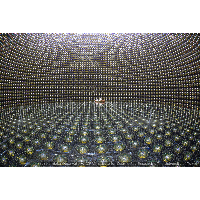Flavour changing ghost particles could give clue to the origin of matter

An international experiment designed to probe one of the biggest mysteries in fundamental physics has yielded some intriguing results.
Researchers at the T2K project in Japan have seen the first piece of evidence that it is possible for neutrinos to change into any one of three different states or ‘flavours’.
The intriguing results indicate a new property of the enigmatic particle. If confirmed, they represent a significant leap forward in understanding.
Lancaster University is one of the UK partners on the T2K neutrino experiment in Japan which is looking closely at neutrinos for answers to the question - where did all the matter in the universe come from?
Neutrinos are among the fundamental building blocks of matter. Known as ghost particles because they are so difficult to observe and interact so weakly with other matter, they are nevertheless all around us and passing through our body all the time.
There are three types of neutrinos (called flavours) – the electron neutrino, the muon neutrino and the tau neutrino. Previous experiments around the world have shown that some of these different flavours of neutrinos can spontaneously change into each other, a phenomenon called “neutrino oscillation”.
Physicists believe these flavour changes could possibly account for the mysterious dominance of matter over anti-matter in the universe.
T2K , which is led by Japan and partly funded by the UK’s Science and Technology Facilities Council (STFC) , is probing the enigmatic neutrino to unprecedented precision by firing the most intense neutrino beam ever designed from the east coast of Japan (Tokai), all the way under the country, to a detector SuperKamiokande, situated in the Kamioka mountains near Japan’s west coast.
Two types of oscillations have already been observed but in its first full period of operation, the T2K experiment has already seen evidence for a new type of oscillation - the appearance of electron neutrinos in a muon neutrino beam.
The experiment ran from January 2010 until 11 March this year, when it was dramatically interrupted by the Japanese earthquake. Fortunately, the multinational T2K team were unharmed and their highly sensitive detectors were largely undamaged. Six clean electron neutrino events are observed in the data from before the earthquake, while in the absence of oscillations there should only have been 1.5. Even though such an excess could only happen by chance about one time in a hundred, that is not good enough to confirm a new physics discovery, so this is called an “indication”.
Dr Laura Kormos, of Lancaster University’s Physics Department, who is part of the T2K team and oversaw the building of a 6 ton particle detector at Lancaster University said today’s announcement was an important milestone but more work was needed.
She said: “Neutrinos are the most capricious and elusive of fundamental particles to measure and understand, yet may have been instrumental soon after the Big Bang in providing a preference for the production of matter over anti-matter without which our universe would not exist. T2K's tantalising but not-quite-conclusive result comes despite the interruption caused by the largest earthquake in Japan's recorded history and demonstrates not only the determination of the T2K collaboration, but also the strength of the design decisions that were made very early on which give T2K an edge at making this measurement. This measurement significantly increases the probability that, with more data, physicists will be able to determine the role of neutrinos in the early universe.”
Lancaster’s work on T2K
Lancaster Physicists built a six ton particle detector which is now at T2K. It was the first of 13 electromagnetic calorimeter modules all of which were built in the UK and which now form part of the near detector in Tokai Japan.
The module, which consists of layers of plastic scintillator bars interspersed with layers of lead alloy enclosed in a carbon-fibre skin, was built and partially calibrated at Lancaster by a large team of staff, technicians, PhD students and researchers managed by Dr Laura Kormos. Its main purpose is to identify and measure the energy of electrons and gamma rays produced by neutrino interactions in target material upstream of the module.
The construction of this first module was used as a blueprint for the construction of the rest of the calorimeter modules, for which the Lancaster group provided training and support.
The Lancaster group is now working to measure neutrino interactions in the near detector as well as to understand better the behaviour of the electromagnetic calorimeter in situ.
In related work, a Lancaster researcher, Dr Nick Grant, has evaluated the number of events that would be expected in Super Kamiokande in the absence of this type of neutrino flavour-change, which contributes to this result.
Another Lancaster researcher, Dr Alex Finch, has provided the T2K software which produces a graphical image of neutrino events in the near detector.
The group was established in 2004 by Professor Peter Ratoff and its work is managed and coordinated by Dr Laura Kormos.